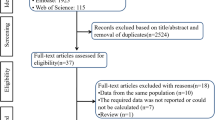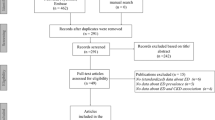Abstract
In this study, we sought to determine the burden and characteristics of orgasmic dysfunction (OD) and concomitant erectile dysfunction (ED) in men with type 1 diabetes (T1D) enrolled in the Epidemiology of Diabetes Interventions and Complications (EDIC) study. In 2010, we assessed orgasmic and erectile function using the International Index of Erectile Function (IIEF). Sociodemographic, clinical, and diabetes characteristics were compared by OD status (OD only, OD and ED, no ED or OD). Age-adjusted associations between risk factors and OD status were examined. OD and ED information was available from 563 men. Eighty-three men (14.7%) reported OD of whom 21 reported OD only and 62 reported OD and ED. Age-adjusted odds ratios demonstrated that men who reported OD only had higher odds of depression, low sexual desire, and decreased alcohol use compared with men reporting no dysfunction. Men with OD concomitant with ED had greater odds of elevated hemoglobin A1C, peripheral and autonomic neuropathy, and nephropathy. Men reporting both dysfunctions were also more likely to report smoking, lower urinary tract symptoms, and had greater odds of androgen deficiency than men with no sexual dysfunction. Men with longstanding T1D suffer from an increased burden of OD. Psychogenic factors predominate in men reporting OD only while men who present with concomitant ED report increased burden of diabetes severity, characteristics previously observed with incident ED. ED may be the central impediment to sexual function in men with OD and ED. Longitudinal studies to characterize OD and ED experience over time are warranted.
This is a preview of subscription content, access via your institution
Access options
Subscribe to this journal
Receive 8 print issues and online access
$259.00 per year
only $32.38 per issue
Buy this article
- Purchase on Springer Link
- Instant access to full article PDF
Prices may be subject to local taxes which are calculated during checkout


Similar content being viewed by others
Code availability
Code is available and can be obtained via correspondence with corresponding author.
References
Brown JS, Wessells H, Chancellor MB, Howards SS, Stamm WE, Stapleton AE, et al. Urologic complications of diabetes. Diabetes Care. 2005;28:177–85.
Wessells H. Insights and interventions in diabetes associated erectile dysfunction. J Urol. 2013;190:15–6.
Lindau ST, Tang H, Gomero A, Vable A, Huang ES, Drum ML, et al. Sexuality among middle-aged and older adults with diagnosed and undiagnosed diabetes: a national, population-based study. Diabetes Care. 2010;33:2202–10.
Burke JP, Jacobson DJ, McGree ME, Nehra A, Roberts RO, Girman CJ, et al. Diabetes and sexual dysfunction: results from the Olmsted County study of urinary symptoms and health status among men. J Urol. 2007;177:1438–42.
NIH Consensus Conference. Impotence. NIH Consensus Development Panel on Impotence. JAMA. 1993;270:83–90.
Jenkins LC, Mulhall JP. Delayed orgasm and anorgasmia. Fertil Steril. 2015;104:1082–8.
Nathan DM. The diabetes control and complications trial/epidemiology of diabetes interventions and complications study at 30 years: overview. Diabetes Care. 2014;37:9–16.
Epidemiology of Diabetes Interventions and Complications (EDIC). Design, implementation, and preliminary results of a long-term follow-up of the Diabetes Control and Complications Trial cohort. Diabetes Care. 1999;22:99–111.
Nathan DM, Zinman B, Crofford O, Genuth S. Diabetes Control and Complications Trial (DCCT): results of feasibility study. The DCCT Research Group. Diabetes care. 1987;10:1–19.
Wessells H, Penson DF, Cleary P, Rutledge BN, Lachin JM, McVary KT, et al. Effect of intensive glycemic therapy on erectile function in men with type 1 diabetes. J Urol. 2011;185:1828–34.
Rosen RC, Riley A, Wagner G, Osterloh IH, Kirkpatrick J, Mishra A. The international index of erectile function (IIEF): a multidimensional scale for assessment of erectile dysfunction. Urology. 1997;49:822–30.
Penson DF, Wessells H, Cleary P, Rutledge BN. Sexual dysfunction and symptom impact in men with long-standing type 1 diabetes in the DCCT/EDIC cohort. J Sex Med. 2009;6:1969–78.
Herman WH, Pop-Busui R, Braffett BH, Martin CL, Cleary PA, Albers JW, et al. Use of the Michigan Neuropathy Screening Instrument as a measure of distal symmetrical peripheral neuropathy in Type 1 diabetes: results from the Diabetes Control and Complications Trial/Epidemiology of Diabetes Interventions and Complications. Diabet Med. 2012;29:937–44.
Martin CL, Albers JW, Pop-Busui R. Neuropathy and related findings in the diabetes control and complications trial/epidemiology of diabetes interventions and complications study. Diabetes Care. 2014;37:31–8.
de Boer IH, Kestenbaum B, Rue TC, Steffes MW, CLeary PA, Molitch ME, et al. Insulin therapy, hyperglycemia, and hypertension in type 1 diabetes mellitus. Arch Intern Med. 2008;168:1867–73.
Bhasin S, Cunningham GR, Hayes FJ, Matsumoto AM, Snyder PJ, Swerdloff RS, et al. Testosterone therapy in men with androgen deficiency syndromes: an Endocrine Society clinical practice guideline. J Clin Endocrinol Metab. 2010;95:2536–59.
Barry MJ, Fowler FJ Jr., O’Leary MP, Bruskewitz RC, Holtgrewe HL, Mebust WK, et al. The American Urological Association symptom index for benign prostatic hyperplasia. The Measurement Committee of the American Urological Association. J Urol. 1992;148:1549–57. discussion 1564.
Ware JE, Snow KK, Kosinski M, Gandek B. SF-36 health survey: manual and interpretation guide. The Health Institute, New England Medical Center. Boston, MA. 1993.
Spector IP, Carey MP. Incidence and prevalence of the sexual dysfunctions: a critical review of the empirical literature. Arch Sex Behav. 1990;19:389–408.
Simons JS, Carey MP. Prevalence of sexual dysfunctions: results from a decade of research. Arch Sex Behav. 2001;30:177–219.
Laumann EO, Paik A, Rosen RC. Sexual dysfunction in the United States: prevalence and predictors. JAMA. 1999;281:537–44.
Chitaley K. Type 1 and Type 2 diabetic-erectile dysfunction: same diagnosis (ICD-9), different disease? J Sex Med. 2009;6 Suppl 3:262–8.
Sadovsky R, Nusbaum M. Sexual health inquiry and support is a primary care priority. J Sex Med. 2006;3:3–11.
Paduch DA, Bolyakov A, Beardsworth A, Watts SD. Factors associated with ejaculatory and orgasmic dysfunction in men with erectile dysfunction: analysis of clinical trials involving the phosphodiesterase type 5 inhibitor tadalafil. BJU Int. 2012;109:1060–7.
Waldinger MD, Olivier B. Selective serotonin reuptake inhibitor-induced sexual dysfunction: clinical and research considerations. Int Clin Psychopharmacol. 1998;13 Suppl 6:S27–33.
Malatesta VJ, Pollack RH, Wilbanks WA, Adams HE. Alcohol effects on the orgasmic-ejaculatory response in human males. J Sex Res. 1979;15:101–7.
Rosen RC. Prevalence and risk factors of sexual dysfunction in men and women. Curr Psychiatry Rep. 2000;2:189–95.
Morley JE. Testosterone and behavior. Clin Geriatr Med. 2003;19:605–16.
Matsumoto AM. ‘Andropause’-are reduced androgen levels in aging men physiologically important? West J Med. 1993;159:618–20.
Rosen R, Altwein J, Boyle P, Kirby RS, Lukacs B, Meuleman, et al. Lower urinary tract symptoms and male sexual dysfunction: the multinational survey of the aging male (MSAM-7). Eur Urol. 2003;44:637–49.
Funding
The DCCT/EDIC has been supported by cooperative agreement grants (1982–1993, 2012–2017, 2017–2022), and contracts (1982–2012) with the Division of Diabetes Endocrinology and Metabolic Diseases of the National Institute of Diabetes and Digestive and Kidney Disease (current grant numbers U01 DK094176 and U01 DK094157), and through support by the National Eye Institute, the National Institute of Neurologic Disorders and Stroke, the General Clinical Research Centers Program (1993–2007), and Clinical Translational Science Center Program (2006–present), Bethesda, Maryland, USA. The authors acknowledge Brandon Haynes contributions to preliminary analyses. Additional statement for collaborators: additional support for this DCCT/EDIC collaborative study (UroEDIC) was provided by an R01 grant (2009–2013) with the National Institute of Diabetes and Digestive and Kidney Disease (5R01DK083927–03).
Author information
Authors and Affiliations
Consortia
Corresponding author
Ethics declarations
Conflict of interest
The authors declare that they have no conflict of interest.
Additional information
Publisher’s note Springer Nature remains neutral with regard to jurisdictional claims in published maps and institutional affiliations.
Members of the DCCT/EDIT Research Group are listed in Supplementary File 1.
Supplementary information
Rights and permissions
About this article
Cite this article
Agochukwu-Mmonu, N., Malaeb, B.S., Hotaling, J.M. et al. Risk factors for orgasmic and concomitant erectile dysfunction in men with type 1 diabetes: a cross-sectional study. Int J Impot Res 33, 59–66 (2021). https://doi.org/10.1038/s41443-020-0242-8
Received:
Revised:
Accepted:
Published:
Issue Date:
DOI: https://doi.org/10.1038/s41443-020-0242-8



